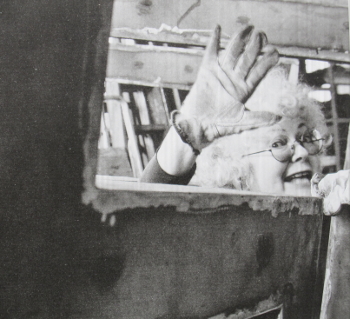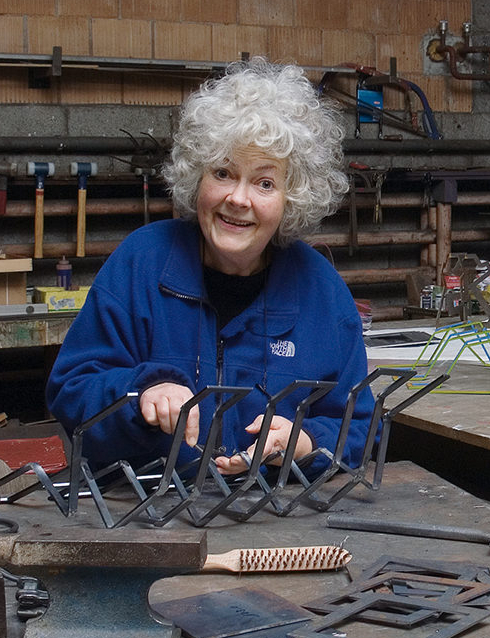|
|
|
|
|
|
GILLIAN |
|
|
|
By Erica Pedretti |
|
|
|
|
Next to her huge sculpture pieces the artist appears to be so small. She is English, yes, English / Swiss; not only does her German and Swiss German sound English but she also looks English despite her extraordinary head of hair. Have you heard her laugh? A hearty laugh, like a spring, a laugh that sound sfrom deep inside, a waterfall. Her large studio, or rather workshop, is full of sculptures, for the most part steel structures, and designs, models, drawings and pictures. When there is not enough space they spill outside into the courtyard where some have already become overgrown by plants. Many of her sculpture pieces stand in public places and how many more are with collectors? She often draws and paints in another studio in the attic of her house. An impressive oeuvre. She also lends a helping hand when erecting sculptures on site. In a definite, but friendly manner she shows her assistants how to assemble the various large and heavy peaces. How does she do it? How does this distinctly feminine woman carry out such heavy work? In 1942 when Gillian White was three years old her family moved into a house near Reading, which her parents had made out of three dilapidated cottages. They produced their own electricity with a two tact motor, had to collect water from a kilometre away and the nearest village was four kilometres away. Her parents were keen gardeners, especially her mother, who created and tended a beautiful garden until she began to suffer from gout. Then in 1958 they sold the house and moved closer to London where her father worked for The Ministry of Transport. Gillie often visited her grandparents on her mother's side who lived in a large farmhouse close to Oxford. Diring the war several evacuees from the towns sought shelter there from the bombs. When she was ten years old she followed her sister, who is six years older, at a boarding shool, Elmhurst School of Ballet in Camberley. This entailed one-hour ballet classes three times a day until her feet went on strike leaving only her sister to become a dancer. When she was fifteen Gillian had to give up dancing; her feet were broken as her bones were too fine. She went to college for a year. But Gillie wantet to study art and nothing else and she was not the first in her family. Her grandmother on her mother's side was a sculptor and her great aunt was a ceramic artist. But her dear father said no! So she earned her own living. Early in the morning she would make breakfast for a dentist in Whigmore Street and serve it in bed, then clean and wash up or she would be a model in another art school. She earned money cookng and being a waitress in restaurants. She modelled small figures for a King Kong film and worked as an extra in Schlesinger's film of Bernard Shaw's Joan of Arc. In the summer holidays she would enamel jewellery. All this was alongside attendance at the Art School. In 1960 she wqent to Paris on her own steam. To the joy of her grandmother from Caen Gillie was following a family tradition - the grandfather of her father had run away from Ireland to France. There she attended The Ecole Superieure de Beaux Arts and again she had to finance her studies through working as a home help for a large family and giving English lessons. A little later Albert Siegenthaler arrived ni Paris to study art. They fell in love. In 1962 they married and continued to study together at the same school until the autumn of 1963 when they moved to London. There they found a cheap flat and work, in fact rather interesting work - restoring Westminster Cathedral. Guy was born in 1964 and Johanna in 1966. For years the children received much love and care from their mother. The young couple lived happily like this for their first five years together in Paris, and in London, where Albert received a grant from The British Council. However, after three years he had to return to Switzerland. In 1966 they moved to Aargau living first with her parents in law and then with the brother in law in Stilli. Following the death of her father in 1972 Gillian was able to sell her parents' house and with her share of the proceeds put down a deposit for the house in Leibstadt where she still lives today. At first they altered very little. Most important for both of the young artists was a large studio. That they built themselves as Gillies's parents had done before them. They were not just painting walls at weekends but constructing the walls and the floor themsselves; one fully laden wheelbarrow after another had to be carted in. Even the roof they constructed themselves only having the help of a bricklayer now and then at weekends. In this new studio with its crane and all the other equipment it was now possible to contruct ever-larger works. These were mainly sculpture pieces made out of Cortensteel, an amalgam of copper, phosphorous and silicon that only rusts on the surface; "the rust protects, it should not rust any further but," according to Gillie, "I don't think that the work will survive that on the Greek sculptures." |
|
|
|
|
Sonn afterwards they won one or the other competition and lived from the down payments but; "by the end we had nothing more." So Gillie taught. Both of the children were at school and Albert was already falling ill. they taught art once a week at the teacher training college at Ramistrasse to help the family get by. The great coup was to win the competition at Lausanne, but Albert was ill and it took ten years before Gillie could realise it. |
|
|
|
The first time that I met Gillian White and Albert Siegenthaler was in 1980 at the sculpture exhibition at Biel. We approached on another and thoroughly examined each other's work. Their sculpture piece Paradise Lost, a huge circular piece, was impressive. Which part was Gillies's The Nordtor (North Portal). Which was Albert's? The Südtor (South portal). And they had worked together on the East and West Portals. The name Paradise Lost was unfortunately ominous as Albert was suffering from a brain tumour. We made friends with one another two years later working on the exhibition Kunst und Natur (Art and Nature) at Lenzburg. The next time we met was at the sculpture symposium in Lindau where Albert was in such a bad way, although he tried to hide it. He could only take part accompanied by Gillie. However, the conversation was unsentimental, lively and often passionate. For years, in fact decades, I have grown and eaten the sheep's kefir culture that Gillie sent me to fight my own cancer. Unfortunately the kefir did not help Albert for much longer. |
|
||
|
Since then a quarter of a century has passed by. Gillies's blonde head of curly hair has turned grey, 'silver' she corrects me laughingly. Her laugh, I don't know of a more endearing laugh, has stayed the same: "I think my curls probably originate from Morocco. Long ago one of my ancestors must fallen in love with an African." At least every three years our paths cross with work for the exhibitionBex et Artswhether it is in 2002 between the bizarre, dancing form of Accordez-moi cette danse(2002) (May I Dance With Your) that constantly changes from every angle or by the rhythmically ordered elements of Shaft in 2005. What will she show this year? And sometimes I meet her at other times, the most considerate of all artists. She thinks of others, constantly putting forward colleagues for competitions and exhibitions. Untiringly she has overcome a sad and terrible time through work and has left it all gbehind her without any bitterness. She has managed to stand her ground, remain passionately focused and continue to develop her art from one piece of work to another, despite resistance and some enmity. Can you hear her laugh? Like a waterfall, that heartfelt, joyful laugh that is so truly Gillie. |
|
||
|
|
|
||
|
(Text: Erica Pedretti, from: Gillian White: Tanz in Eisen. Werke aus 40 Jahren / Dance in Steel. 40 Years' Work. Eds. Sabine Altorfer, Uli Däster, Jochen Hesse. 2009. 165 S. m. 160 Colour- and BW Figures. 26,5 x 30 cm. Issued by: SCHEIDEGGER & SPIESS 2009. ISBN: 3-85881-251-X ) |
|
INDEX | BIOGRAPHY | BIBLIOGRAPHY | EXHIBITIONS | WERKVERZEICHNIS | CONTACT | U. DAESTER | E. PEDRETTI | S. ALTORFER
< Back

